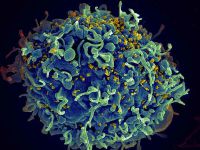About-cancer/causes-prevention/risk/infectious-agents/zh
Contents
傳染媒介
某些感染因子,包括病毒,細菌和寄生蟲,可能導致癌症或增加癌症形成的風險。 一些病毒可以破壞通常使細胞生長和增殖受到控制的信號傳導。 同樣,某些感染會削弱免疫系統,使人體抵抗其他致癌感染的能力降低。 一些病毒,細菌和寄生蟲也會引起慢性炎症,這可能導致癌症。 與癌症風險增加有關的大多數病毒可以通過血液和/或其他體液從一個人傳播到另一個人。 如下所述,可以通過接種疫苗,進行無保護的性行為和不共用針頭來降低感染風險。
愛潑斯坦巴爾病毒(EBV)
EBV是一種皰疹病毒,會引起單核細胞增多症以及某些類型的淋巴瘤和鼻喉癌。 EBV最常通過與唾液接觸而傳播,例如通過親吻或共享牙刷或水杯來傳播。 它也可以通過性接觸,輸血和器官移植而傳播。 EBV感染是終生的。 全球超過90%的人一生中都會感染EBV,並且大多數人不會出現任何症狀。 沒有疫苗可以預防EBV感染,也沒有針對EBV感染的特殊治療方法。
乙型肝炎病毒和丙型肝炎病毒(HBV和HCV)
HBV或HCV的慢性感染可導致肝癌。 兩種病毒均可通過血液傳播(例如,通過共用針頭或通過輸血),並在出生時從母親傳播給嬰兒。 此外,乙肝病毒可通過性接觸傳播。
自1980年代以來,美國和大多數其他國家/地區的嬰兒已常規接種了HBV感染疫苗。 專家建議未接種HBV疫苗且感染HBV的風險較高的成年人應儘快接種疫苗。 疫苗接種對於與人血接觸的醫護人員和其他專業人員尤其重要。
美國疾病控制與預防中心(CDC)還建議對美國1945年至1965年之間出生的每個人以及其他感染HCV感染風險增加的人群進行HCV檢測。 儘管目前沒有針對HCV的疫苗,但新療法可以治癒人們的HCV感染。 如果您認為自己可能有HBV或HCV感染的危險,請詢問您的醫生以進行檢查。 這些感染並不總是會引起症狀,但是測試可以顯示您是否感染了病毒。如果是這樣,你的醫生可能會建議治療。 另外,您的醫生可以告訴您如何避免感染他人。
人類免疫缺陷病毒(HIV)
HIV是導致獲得性免疫缺陷綜合症(AIDS)的病毒。 愛滋病毒本身並不會引起癌症,但是感染愛滋病毒會削弱免疫系統,使人體抵抗其他導致癌症的感染的能力降低。 感染HIV的人罹患多種癌症的風險增加,尤其是卡波西肉瘤,淋巴瘤(包括非霍奇金淋巴瘤和霍奇金病)以及子宮頸癌,肛門癌,肺癌,肝癌和咽喉癌。
HIV可以通過血液和性接觸傳播。 與其他男人無保護的性行為的男人以及共用注射針頭的人們感染愛滋病毒的風險最高; 與多個伴侶無保護的性行為的異性戀個體處於次高風險。
人們在開始出現症狀之前可能已經感染了愛滋病毒多年。 如果您認為自己有感染HIV的危險,請向您的醫生詢問是否接受檢測。 如果您測試呈陽性,則您的醫生可以開出高效的抗病毒藥,並告訴您如何避免感染他人。 有關更多信息,請參見HIV感染和癌症風險情況說明書。
人乳頭瘤病毒(HPV)
Infection with high-risk types of HPV cause nearly all cervical cancers. They also cause most anal cancers and many oropharyngeal, vaginal, vulvar, and penile cancers. High-risk HPVs spread easily through direct sexual contact, including vaginal, oral, and anal sex. Several vaccines have been developed that prevent infection with the types of HPV that cause most HPV-associated cancers. In the United States, experts recommend that children be vaccinated at age 11 or 12, but children as young as age 9 and adults as old as 26 can also be vaccinated.
Cervical cancer screening can be used to detect signs of HPV infections in the cervix. Although HPV infections themselves cannot be treated, the cervical abnormalities that these infections can cause over time can be treated. For more information, see HPV and Cancer and the Human Papillomavirus (HPV) Vaccines and HPV and Pap Testing fact sheets.
Human T-Cell Leukemia/Lymphoma Virus Type 1 (HTLV-1)
HTLV-1 can cause an aggressive type of non-Hodgkin lymphoma called adult T-cell leukemia/lymphoma (ATLL). This virus spreads via blood (by sharing needles or through transfusions), through sexual contact, and from mother to child in the womb or via breastfeeding. Infection with this virus is more common in Japan, Africa, the Caribbean, and South America than in the United States. Most people with HTLV-1 infection do not have any symptoms or develop disease.
Blood is routinely screened for HTLV-1 in the United States. There is no vaccine to prevent infection with this virus and no treatment if you are infected. If you think you may be at risk for HTLV-1 infection, ask your doctor about being tested. If you test positive, your doctor can tell you how to keep from infecting other people and monitor you for HTLV-1-induced disease.
Kaposi Sarcoma-Associated Herpesvirus (KSHV) Kaposi sarcoma-associated herpesvirus (KSHV), also known as human herpesvirus-8 (HHV-8), can cause Kaposi sarcoma. KSHV can also cause primary effusion lymphoma and multicentric Castleman disease.
KSHV is most commonly spread through saliva. It can also be spread through organ or bone marrow transplantation, and there is some evidence that it can be spread by blood transfusion, although this risk is minimized by practices followed in the United States such as blood storage and removal of white cells.
KSHV infection is generally limited to certain populations, and the way KSHV is spread varies among these populations. In sub-Saharan Africa and certain regions of Central and South America, where KSHV infection is relatively common, it is believed to spread by contact with saliva among family members. In Mediterranean countries (Italy, Greece, Israel, Saudi Arabia), where KSHV infection is present at intermediate levels, it is thought to spread by contact among children and by ill-defined routes among adults. Finally, in regions where KSHV infection is uncommon, such as the United States and Northern Europe, it appears to be mostly transmitted sexually, especially among men who have sex with men.
Most people infected with KSHV do not develop cancer or show any symptoms, although those who also have HIV infection or are immunosuppressed for other reasons are more likely to develop KSHV-caused diseases. There is no vaccine to prevent KSHV infection and no therapy to treat infection. Men who have sex with men may be advised to avoid oral–anal contact (including use of saliva as a personal lubricant). And people who are infected with HIV can lower their risk of KSHV-related complications by using antiretroviral therapy.
Merkel Cell Polyomavirus (MCPyV)
MCPyV can cause Merkel cell carcinoma, a rare type of skin cancer. Most adults are infected with MCPyV, with transmission most likely occurring through casual direct (i.e., skin-to-skin) or indirect (i.e., touching a surface that an infected person has touched) contact in early childhood. The risk of Merkel cell carcinoma is greatly increased in elderly people and in younger adults with who are infected with HIV or are immunosuppressed for other reasons. Infection does not generally cause symptoms, and there are no treatments for MCPyV.
Helicobacter pylori (H. pylori)
H. pylori is a type of bacterium that can cause noncardia gastric cancer (a type of stomach cancer) and a type of lymphoma in the stomach lining, gastric MALT lymphoma. It can also cause stomach ulcers. The bacterium is thought to spread through consumption of contaminated food or water and direct mouth-to-mouth contact. The CDC estimates that approximately two-thirds of the world’s population harbors H. pylori, with infection rates much higher in developing countries than in developed nations. In most populations, the bacterium is first acquired during childhood.
If you have stomach problems, see a doctor. Infection with H. pylori can be detected and treated with antibiotics.
For more information, see the Helicobacter pylori and Cancer fact sheet.
Opisthorchis viverrini
This parasitic flatworm (fluke), which is found in Southeast Asia, can cause cholangiocarcinoma (cancer of the bile ducts in the liver). People become infected when they eat raw or undercooked freshwater fish that contain the larvae. Antiparasitic drugs are used to treat the infection.
Schistosoma hematobium
This parasitic flatworm (fluke), which lives in certain types of freshwater snails found in Africa and the Middle East, can cause bladder cancer. People become infected when infectious free-swimming flatworm larvae burrow into skin that has come into contact with contaminated fresh water. Antiparasitic drugs are used to treat the infection.
